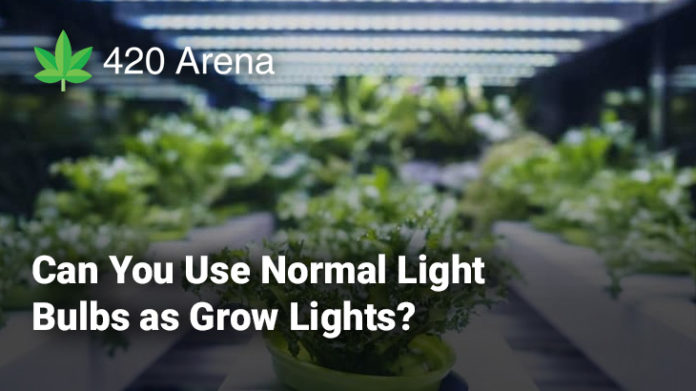Among many questions that we get asked about grow lights and growing marijuana indoors, one of the most common ones is that of “Can you use normal light bulbs as grow lights”. The answer to this question is no, you shouldn’t. But shouldn’t doesn’t mean can’t. However there’s a deep-seated reason as to why these lights should not be used to grow your plants and in this article, we hope to explore that reason in great detail. By the end of this article, you will understand why grow lights are important and why they are special when compared to regular light bulbs which are not as effective.
We will be answering a number of different questions along the way and we hope that this acts as the perfect guide to grow lights and everything that you need to know about them from the most basic to some of the most complex levels.
Why Do Plants Need Light?
Talking of the basics, one of the first questions that we believe we need to answer is – why do plants even need light? Plants require light to grow, to bloom, and to make food. Basically, light to them is like oxygen to us. Plants get light in the form of sunlight while growing in nature. This light triggers the process of photosynthesis where the light gets converted to energy. It helps plants prepare food that allows them to sustain themselves and grow. It also allows them to break down various compounds and enzymes inside their bodies. Plants also require light for a number of other reasons – the color, texture, taste, smell of plants all comes from the light. Hence, it is critical that plants get proper access to light. But that is not possible in case you are growing them indoors because there is no access to the natural light of the sun when growing them indoors.
- How to Provide Light When Growing Plants Indoors?
When you grow your plants indoors, you need a specialized kind of a lighting solution, which comes in the form of grow lights. These lights help your plants get the right kind of lighting even while growing indoors. Grow lights are made in such a way that they provide a light to your plants which is beneficial to them and resembles the natural light of the sun to a large extent. It is here that the question arises – can you use a normal light bulb as a grow light? Let us now take a look at the difference between a regular bulb and a grow light bulb:
Can You use Normal Light Bulbs as Grow Lights?
A grow light bulb is specifically created to provide the kind of light that the plants require. Plants just don’t need light, but they need the light of a specific spectrum and wavelength. This can be provided to them using grow lights. Normal household bulbs or incandescent bulbs are not useful here because they emit light of a very short range and the light that comes from these bulbs is not entirely useful to the plants (or in some cases, not useful at all). While plants do need ‘light’ to grow, any light doesn’t work. They require specific kinds of light which grow lights can offer.
Regular household bulbs lack the color temperature, as well as the right kind of wavelength for the plants. These bulbs have little to no impact on the overall growth and development of the plant. While they might be enough to keep some low-maintenance plants alive, plants would not grow or thrive under these lights. These are just enough to keep them alive but can’t sustain or nurture them. Especially in the case of plants such as marijuana, which need the right kind of lights to ensure that their THC and CBD levels are up to mark, these bulbs are useless. Some plants which don’t have high requirements such as succulents or small shrubs can barely manage to survive under normal light bulbs but even they won’t perform as well as they would under grow lights.
Different Types of Grow Lights
Here’s a look at the different kinds of grow lights that are out there. This will help you get a better understanding about the options in the markets and the specific benefits of each of these:
1. HID Grow Lights
High-Intensity Discharge (HID) grow lights are useful for those growers who are looking forward to growing plants under a bright light but are comfortable using power-consuming lights that carry chemicals in them. These lights provide a high wattage and are single-spectrum, but help the plants thrive during their respective phases of growth. There are two types of HID lights –
- Metal Halides
These are the cool blue HID lights which provide the kind of lighting that is more suited to vegging plants. The light is produced when current is passed through a mixture of mercury vapor and metal halides. These lights operate at a color temperature of 6000-6500K
- High-Pressure Sodium Grow Lights
Popularly known as HPS grow lights, these grow lights operate at a color temperature of about 2500-2700K and are better suited for flowering plants. Here, sodium vapor is lit up in a similar manner and produces the red lights that help plants bloom better.
2. Fluorescent Grow Lights
These kinds of grow lights are similar to what we see at home in look and feel as CFL bulbs and tube lights are common household fixtures. However, on the inside, they have chemicals which produce UV lights when vaporized and the light is then converted into the visible spectrum with the help of a phosphorus coating.
- CFL Lights
These are similar to the CFL bulbs in homes but function on the mechanism described above. These lights are extremely cool and operate at very low temperatures. CFL grow lights come in two variants – warm white and cool white, for flowering and vegging respectively. These are popular among growers as add-on lights for giving a boost to their existing lights.
- T5/8/12 Lights
These are tube-shaped lights which function on pretty much the same principle. These lights come in three diameters – T5, T8 and T12. T5 is ⅝ of an inch, T8 is 1 inch and T12 is 12/5, which is 1.5 inches in diameter. These lights are more commonly used by growers who want to use them as a primary source of lighting (unlike CFLs which are secondary sources).
3. LED Grow Lights
The latest innovation in indoor lighting – LED lights are all the rage. These lights consume the least amount of energy while offering the brightest lumen per watt output. LED grow lights tend to operate at cooler temperatures compared to HID lights, and they are also chemical-free and hence safe to operate and dispose. These lights also have a huge lifespan – of about 100,000 hours or even more. LED grow lights come in different types too – there are regular SMD LED lights, then there are Quantum Board lights and COB lights which are a more recent spin on regular grow lights.
How To Choose the Best Grow Light for Your Plants?
Now that you know about the different types of grow lights and how they are to be used, as well as whether normal light bulbs as grow lights is a good idea or not, let us take a look at some things you must keep in mind while buying a grow light:
- Coverage: You must know the area that your plants occupy and then compare the area that the light provides to cover. There will be two metrics – vegging and flowering. Always look at the latter to get a better and a more accurate information.
- Lighting and Spectrum Details: You must know the kind of spectrum in which your grow light operates. Full-spectrum lights are the best for growing plants, but many growers also prefer buying different grow lights for the red and blue spectrums.
- Power Consumption: A very important thing to consider is the exact amount of power that your grow light is going to draw from the power socket. You must know this in advance as this will help you plan your finances better and you would know exactly how much you are investing in your growth setup.
- Heat Dissipation: Make sure that the light that you are buying does not emit too much heat. This would lead to the plants getting damaged – or the light itself getting damaged. Also while you are at it check if your light has undergone all the testings and certifications for fire safety!
- Color Temperature: In some cases, you need to check the color temperature of your lights too. A temperature between 6000 and 6500 Kelvins is best for your vegging plants and about 2500-3000K is best for your flowering plants.
- Stage of Growth of Your Plant: If your plant is in the vegging stage you’d need a light that provides the blue lighting such as Metal Halides or Cool White lights. In case your plants are flowering, you’d need red lights like HPS grow lights or warm white lights.
- Brand Credibility: Getting a better brand is always good because you know that there are years of research behind them and that they are more likely to honor their guarantee/warranty. They are also likely to have a better customer care system than compared to obscure brands.
- Warranty, Cost, Lifespan of the Bulb: Lifespan is very important here! Make sure you get long-lasting grow lights. The warranty period is something that you must check on any product, grow light or not! Lastly, cost too plays a major role – so prepare a budget before you head out to shop and make sure that you stick with it!
How Far Should The Light be from the Plants?
The answer to this question depends upon the kind of light that you are using and the phase of growth that your plant is in. Usually lights such as LED grow lights or fluorescent lights which tend to operate at cooler temperatures can be placed closer to plants than compared to the lights like HID grow lights which generate a lot of heat. Furthermore, plants need lights closer to them during the flowering stages than compared to the vegetative stages of their growth. This is why when you buy a grow light there are two different readings for flowering and vegging – with the latter generally having a larger coverage area.
What Color of Light Do Plants Need?
When answering the question of “Can you use normal light bulbs as grow lights”, it is important to understand why they should not be used. While any light bulb CAN be used to grow your plants, not all of them are suitable enough to provide an all-round growth and your plants will suffer if you do not use the right kind of lighting. This is primarily because of two reasons: you need the right color, and you need to provide the right color of lighting during the right phase of growth. In this section, we take a detailed look at the different colors of light and how they affect your plants, as well as the different phases of a plant’s growth cycle and what kind of a light is needed during them.
What Different Colors Do to a Plant
For a grower it is essential to know beyond just the reds and blues. Everyone who has even started off with growing knows that red and blue lights are great for a plant – but it is important to know what these colors do, and what do the other colors of the visible spectrum do to a plant as well. Since normal light bulbs do not provide such a range of colors, it is generally not suitable for the growth of a plant as all these colors carry their own benefits:
- Ultra Violet (UV Lights): UV lights help marijuana plants develop resins which ensures a higher and better THC content. This is what makes the buds more potent and the plants give you a better ‘high’. These lights also have anti bacterial properties, and also help increase the root mass and even out the branching among other things.
- Violet: When you look at it individually, the violet light isn’t really effective and does nothing. However, when you combine the effect of this light along with the red or blue lights, you’d find it adding on to the taste and the smell of your weed.
- Blue: Here we come to one of the most important colors for a plant. Blue lights are essential during the vegetative phase (and even beyond). These lights help the plants get a better growth and develop thicker foliage. These ensure that the plants remain green. This color of light is also the easiest to be absorbed by chloroplasts and helps generate better chlorophyll.
- Green: Green light isn’t really that effective in much else but is actually a helpful factor in adding on to the generation of chlorophyll and helps keep the plants green. This light has the ability to impact the deepest seated photoreceptors of the plants and helps the plants grow overall.
- Yellow: This is perhaps the least useful kind of light for plants. Yellow light doesn’t do much and is known to have no major effect on plants. However, getting some of it is considered overall beneficial.
- Orange: Orange light is beneficial for the flowering plants – but in a much less effective way than actual red lights. Orange lights pave the way for red lights to help the plants bloom better but aren’t really important when you look at them in isolation.
- Red: Another of the most important types of lights that your plants need, red lights help in the flowering and the blooming stages of a marijuana plant’s growth cycle. Red lights ensure that you get bigger buds and big flowers. This is a very important kind of a light and is generally provided in full-spectrum lamps all-round the season.
- Far Red (IR Lights): Lastly, these Infrared lights are another factor which aid the growth and development of the plant and affect them on an overall level – something needed right from germination to pre-harvest phases.
Different Stages Different Lighting
With the knowledge of what benefits the different shades of light bring to the plants, let us now take a look at the different phases of growth of a marijuana plant and understand which kind of light do the plants need at different phases. Knowing this would help you understand why you should not use normal light bulbs as grow lights:
- Seed: The earliest and the most basic phase of a plant’s growth cycle, a plant can remain a seed for a long time before a grower plans to germinate it. In the seed stage the light does not matter – you could provide any light or not provide any light at all and it would not have any effect.
- Germination: The first stage of growing a plant starts with germinating the seeds. Germination, too, like the seed stage, does not require any light. It is generally done in dark, warm and moist environments.
- Seedling: This is where the role of light begins! Plants require light from the seedling stage, when they start showing signs of growth. Cool blue lights are extremely important here and they need to be provided to the plant in large quantities. A seedling could need as many as 22 hours of the right kind of lighting.
- Vegetative Growth: The stage of vegetative growth begins when the seedling has grown a little larger but is not a full-blown plant yet. In the vegging phase, the plantling matures into a proper plant and it takes many weeks. All through this time, you need to provide cool blue lights along with some red lights that would help the plant grow bigger and sturdier, as well as develop more foliage. You could now reduce the total lighting hours to about 16 hours.
- Pre-Flowering: This is where you begin providing a large number of red lights, while also providing blue lights. Pre flowering plants need a good amount of light but this is a critical junction. Once your plants are in the pre-flowering phase for some time, you could manually trigger the flowering phase by reducing overall lighting hours to about 12.
- Flowering: Flowering plants need a lot of red light. At this phase you also need to bring the lights a little closer to the plants. About 10-12 hours of light a day from a closer distance is great for your plants in the flowering phase. However, while bringing lights close make sure you do not bring them so close that they burn the tops of the flowers.
- Harvest: Again, no light needed in this phase!
Frequently Asked Questions About Grow Lights
Here’s a collection of some of the most common and frequently asked questions that we get around this topic. Do go through them to help get a better understanding of grow lights:
1. Which is the best grow light when it comes to saving power?
There’s no definitive answer to THE single most effective grow light for saving power, but in general, LED grow lights tend to save you much more power than compared to HID or Fluorescent lights. In fact, LED grow lights save you so much power in comparison to these older forms of lighting that in the long run of using these lights, you are saving more money than you had spent buying them!
2. Which is the best grow light for vegetative plants?
When it comes to plants in the vegetative phase of growth, growers should look for lights that provide them with a bluish tint. Blue lights are the best for vegetative plants and they help them get bushier, greener, and develop better foliage. If you are using HID lights then we suggest you go for Metal Halides and if you are using fluorescent lights, then cool white lights with a color temperature of about 6000-6500K are the best suited for your needs. In case of LED lights, get a full spectrum LED light and you don’t really need to worry about anything else.
3. Which is the best grow light for flowering plants?
Flowering plants need a very different kind of a lighting experience when compared to vegging plants. These grow lights require red lights – these lights help the growers ensure that they provide their plants with the right kind of light that promotes the blooming and flowering of their plants. When using HID lights, you should go for HPS grow lights here, and when using fluorescent lights, go for Warm White lighting which is best suited for flowering plants. LED lights, however, are anyway full-spectrum so you won’t have to buy a separate grow light for flowering.
4. Where can I buy grow lights?
Grow lights are commonly available in any store around the world which sells gardening supplies and particularly indoor gardening supplies. LED lights, Fluorescent lights, and even HID lights can be found at all stores. However, one of the best platforms for purchasing grow lights these days is Amazon – where you can get a large variety from where you can choose and decide the light that suits your needs the best.
5. How much do grow lights cost?
Different grow lights cost different amounts. Based on what kind of a grow light it is, what brand it comes from, and what kind of parts it uses inside – the light can vary from between $100 to $1000 and in some cases even more. If you buy a grow light kit – it might be even more expensive.
6. Is it legal to use grow lights?
Using grow lights is completely legal and is never a problem. You can use the lights to grow as many plants as you want as long as they are legal. However, if you are growing an illegal plant (such as marijuana in some areas), then you might run into trouble with the law because of the plant, but not because of the grow light!
Conclusion
This is one article that we had wanted to publish for quite some time as hardly any day goes without people asking us this question – “Can I use regular lights to grow plants”. The answer to this is quite complicated and so far it was like, if you know, you know, if you don’t, it will be hard to explain. However, in this article, we have provided a detailed and an in-depth explanation which talks about how grow lights function and which are the kinds of lights that you could use to grow plants. While technically every light can be used to grow plants, not all of them are suitable enough for it. Plants need ‘ideal light’ to grow and thrive or else they would always be lacking in something. We hope that this article resolves all your queries about the topic. If there are any more questions that you want to be answered, feel free to send us a mail or let us know in the comments below! Till then…
….Happy Growing 🙂
Table of Contents


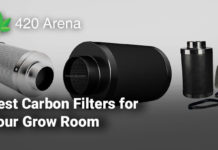
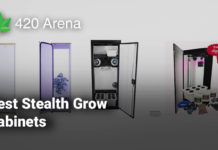
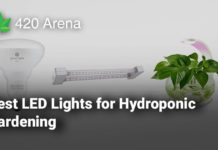

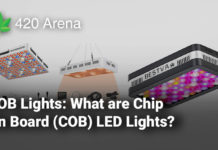


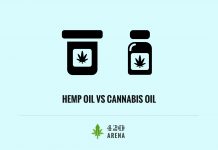
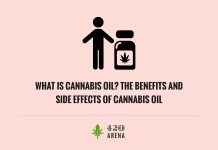

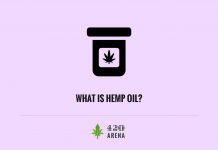
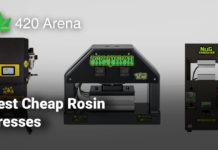
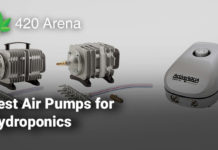
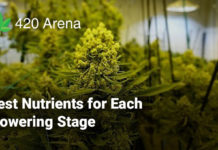
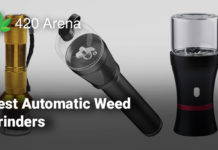
![How to Use Carbon Filters in Your Grow Room [7 Best Carbon Filters for Grow Rooms in 2021] How to Use Carbon Filters in Your Grow Room](https://420arena.com/wp-content/uploads/2020/12/How-to-Use-Carbon-Filters-in-Your-Grow-Room-218x150.jpg)





